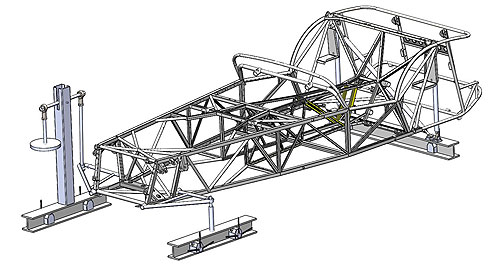News - CaterhamCaterham adopts bicycle techProduction cycle: By combining Simpact engineering with Reynolds specialised materials, Caterham has applied weight-saving bike technology to an old English favourite. Reynolds butted tubing cuts Caterham chassis weight by 10 per cent31 Mar 2016 LIGHTWEIGHT sportscar-builder Caterham has teamed up with two additional British specialists Reynolds Technology and Simpact to reduce the mass of its already featherweight chassis by 10 per cent by using technology normally confined to the world of bicycles. While its regular space-frame chassis uses uniform gauge steel tubing for its construction, Reynolds lent the car-maker its expertise in bike frame butted tubes, which have varying wall thickness for the optimum strength-to-weight ratio. Building the prototype was not simply a case of swapping out Caterham's regular materials for the Reynolds tube and instead required the virtual analysis and testing capability of Simpact Engineering – the third partner in the project. With a regular Caterham Seven 270 chassis tipping the scales at about 55kg, a weight saving of 5.5kg might not sound like much, but with a rolling mass of 540kg, every kilo counts, and has the potential to boost dynamics. For the prototype, Caterham stuck to Reynolds' experience in steel for its cost effectiveness and ease of manufacture, however pairing the butted tube tech with more exotic materials has the potential for even greater weight saving. By using steel instead of other more expensive metals, the car-maker says the lighter chassis will cost between £1000 and £2000 ($A1875 and $A3750) with up to a fifth of customers predicted to choose the lighter option if it is introduced. Caterham is yet to confirm a factory version. Reynolds has been developing the science of butted tubing since 1897 and it manufactures the tubes with a mandrel press and die process followed by reeling, which maintains a constant outside diameter with varying internal dimensions. For the automotive application, Reynolds had to develop new tooling and techniques, as its more bicycle-specific production approach was not suitable for the greater complexity of a car's space-frame chassis. Some regions of the chassis were reduced in weight but as much as 50 per cent without sacrificing any torsional stiffness or strength according to the company. The pursuit of lighter sportscar design is clearly primarily in the name of performance, but interestingly, Caterham Cars CEO Simon Lambert highlighted the weight reduction's effect on fuel economy. “Caterham has made its name as a purveyor of lightweight sportscars but we believe more can always be done to reduce weight and, therefore, emissions,” he said. “Caterham and Reynolds are two proudly British brands and there is a real synergy between customers of Caterham and cycling enthusiasts, so it’s even better that the technology that has made this possible has come from the two-wheeled world.” The development of the new chassis was made possible with funding from the Niche Vehicle Network – an organisation that supports the UK's widespread boutique sportscar industry, and is in turn funded by the Office for Low Emission Vehicles (OLEV). Reynolds Technology managing director Keith Noronha said the union between the established British brands was a good fit for his company. “We have had to expand our capabilities to meet the technical challenges seen during the course of this collaborative project, and are delighted to see specifically engineered butted tube now in use on the iconic Caterham Seven,” he said.  |
Click to shareCaterham articlesMotor industry news |





















Facebook Twitter Instagram